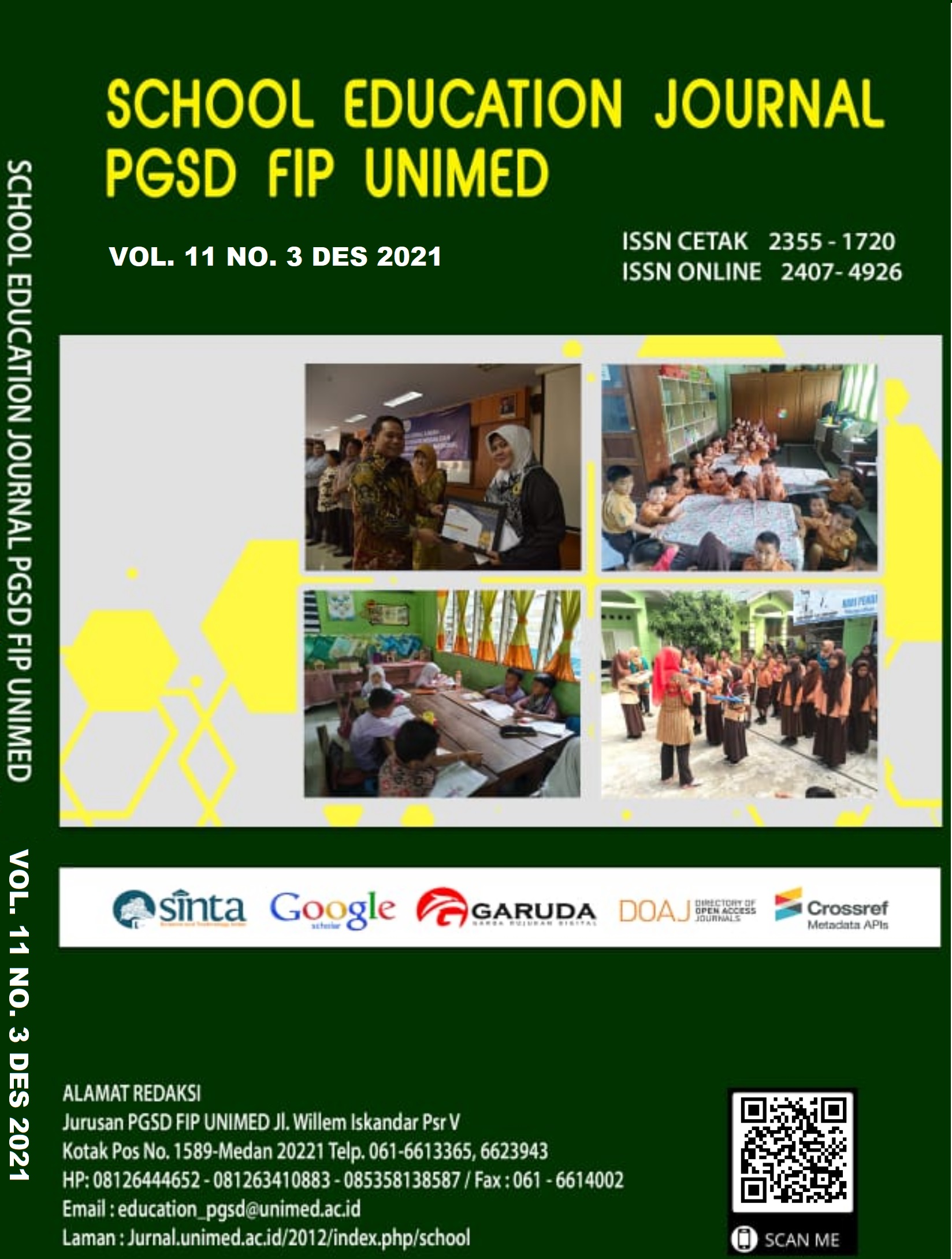PENGEMBANGAN MULTIMEDIA INTERAKTIF BERBASIS MACROMEDIA FLASH PADA PEMBELAJARAN TEMATIK TERPADU KELAS IV SEKOLAH DASAR
DOI:
https://doi.org/10.24114/sejpgsd.v11i3.27213Abstract
This type of research is R&D Research (Research and Development). This study uses a 4-D development model, which consists of the stages of definition (define), design (design), development (develop), dissemination (disseminate). The instrument used is expert validation, teacher and student responses. The results of the developed media research show: (1) Interactive multimedia based on macromedia flash on theme 8 sub-theme 2 in elementary school is declared very valid with an average score of 90.6% media experts, experts material 92% and linguists 88%, (2) The responses of teachers and students to the interactive multimedia trial based on macromedia flash 8 on theme 8 sub-theme 2 in elementary school obtained a very practical category with an average value of 92.5% and 88% (3 ) The response of teachers and students to the distribution of interactive multimedia based on macromedia flash 8 on theme 8 sub-theme 2 in elementary school obtained a very practical category with average values of 95% and 82.6%Keywords: Development, Macromedia Flash, 4-D ModelReferences
Andini, Selfi Rahmi., Fitria. Y. 2021. Pengaruh Model RADEC Pada Pembelajaran Tematik Terpadu Terhadap Hasil Belajar Peserta Didik Sekolah Dasar. Jurnal Basicedu, 5(3), 1435-1443.
Daryanti, Desyandri & Fitria. Y. 2019. Peran Media Dalam Pembelajaran Seni Budaya Dan Keterampilan Di Sekolah Dasar. Edukatif: Jurnal Ilmu Pendidikan, 1(3), 215-221.
Elisa, L., Fitria, Y., Padang, U. N., Padang, U. N., Padang, U. N., & Padang, U. N. 2019. Application Oflearning Model Auditory, Intellectually, Repetition (Air) To Increase Student Activity And Learning Outcomes In 2013 Curriculum Integrated Thematic Learning In Class Iv Sdn 06 Hand Of Padang. 1(2), 156 “ 162.
Fitria, Yanti. 2016. Penguatan Pengajaran Guru Sains Level Dasar Dengan Strategi Pendidikan Karakter Berbasis Literasi Sains. KONASPI VIII: Universitas Negeri Jakarta
Fitria, Yanti. 2018. Landasan Pembelajaran Sains Terintegrasi (Terpadu) Untuk Level Dasar. Padang: Sukabina Pers.
Hamalik. 1994. Media Pendidikan. Bandung: Citra Aditya Bakti
Indriyani, D., Desyandri., Fitria, Y & Irdamurni. 2019. Perbedaan Model Childern™s Learning In Science (CLIS) Dan Model Scientific Terhadap Hasil Belajar Siswa Pada Pembelajaran Tematik Terpadu Di Kelas IV SD. Jurnal Basicedu, 3(2), 627-633
Mardhatillah dan Trisdania, E. 2018. Pengembangan Media Pembelajaran Berbasis Macromedia Flash 8 untuk meningkatkan Kemampuan Membaca Siswa di Sd Kelas II Negeri Paya Peunaga Kecamatan Meuboro. Bina Gogik, 5(1), 2355-3774
Rahmi, Mar™atush Sholichah Muntaha, Dkk. 2019. Pengembangan Media Pembelajaran Interaktif Macromedia Flash 8 Pada Pembelajaran Tematik Tema Pengalamanku.International Jurnal Of Elementary Education. Vol. 3 No. 2, Mei 2019, Hal 178 “ 185.
Sugiyono. 2018. METODE PENELITIAN PENDIDIKAN (Pendekatan Kuantitatif, Kualitatif, Dan R&D). Bandung: Alfabeta.
Taupik, Riska Putri., Fitria. Y. 2021. Pengaruh Model Pembelajaran Project Based Learning Terhadap Pencapaian Hasil Belajar IPA Siswa Sekolah Dasar. Jurnal Basicedu, 5(3), 1525-1531
Wahyugi, R & Fatmariza. 2021. Pengembangan Multimedia Interaktif Menggunakan Software Macromedia Flash 8 Sebagai Upaya Meningkatkan Motivasi Belajar Siswa Sekolah Dasar. Jurnal Basicedu, 3(3), 785-793.
Downloads
Published
Issue
Section
License
Authors whose manuscripts are approved are approved as follows:
The publication rights for all journal manuscript materials published/published on the SEJ (School Education Journal) E-Journal site are held by the editorial board with the author's knowledge (moral rights remain with the manuscript authors).
The formal legal requirements for accessing this electronic digital journal article are subject to the terms of the Creative Commons Attribution-ShareAlike (CC BY) license, which means that E-Journal SEJ (School Education Journal) has the right to store, transfer media/format, manage in the form of a database, maintain, and publish articles without asking permission from the author as long as the author's name remains as the copyright owner.
Manuscripts published/published electronically are open access for educational, research, and library purposes.

